(I'm testing posting by email). We're on vacation, enjoying the holidays with family. Wishing you all a joyous Christmas! Mele Kalikimaka!
Saturday, December 24, 2011
Saturday, December 03, 2011
Ketchup = Catch up
The problem with trying to write about a long trip, I find myself thinking, is you (I) have to be sure you (I) don't run out of steam before you (I) actually finish writing about the whole trip. So far, I think I've gotten just half way through our trip up the Coast.
I need to regroup a little, get back to editing and posting the photos from the trip and checking my notes to finish sharing the stories.
In the meantime, October was really long. LOOOOooooOOOng. And, wow, where did November go? Maybe finishing writing about the trip will be a Start-of-2012 project. [Ahem]
October:
Mini pumpkins -
Finished crocheting a scarf -
(taking a
Got sick -
(I'm sure you can imagine it without the visuals)
November:
Rain -
(See? It does rain in Southern California)

Got to 500 miles Run/Walking for the year-
(photo already posted, below)
December:
So far, Big Wind (Pasadena was called the epicenter of the windstorm).
[sigh]
Posted by
Wendee
at
10:36:00 PM
1 comments
![]()
Labels: catchup, celebrations, crafting, food, life
Thursday, November 24, 2011
Friday, October 07, 2011
Drive up the Coast, Part 5: Moseying along
In addition to the redwoods, there was, of course, more to see.

We moseyed over to Humboldt Lagoons State Park, just west of Redwood National Park. Driving the precariously narrow and steep road, having seen lots of large trucks blasting up or down, we were leery. We got halfway down, peered out and went, “Oooooh”. The lagoons are shallow bays between rocky headlands* where coastal wave action has formed a sandy bar separating each lagoon from the Pacific Ocean. The lagoons are resting areas for migratory waterfowl.
From where we parked, you could gaze out one direction and see only the lagoon:

then turning to look the other way, beyond the wide golden beach, the Pacific Ocean:

From the Humboldt Lagoons State Park, California State Parks website and Wikipedia:
Gold-seekers swarmed into the area in 1849 when discoveries were made along the Klamath and Trinity rivers. Prospectors attempted to mine the sandspits along Big and Stone lagoons, but managed to extract very little gold despite considerable effort. In the early 1900's Dry Lagoon was drained by early farmers and several types of crops were attempted but none proved economical. Several dairy ranches were established along the shores of Stone Lagoon. Today the marshland habitat has returned and supports a rich variety of marsh plants, birds and other animals.
We stayed for a while; there was plenty to take in.
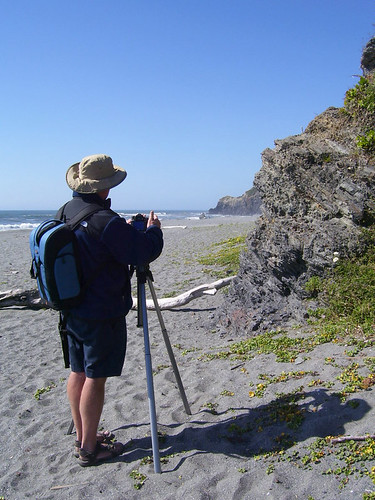

We also stopped at Trinidad Head Lighthouse.
The low, square, brick tower was built in 1871. The light is only 20 feet above ground, but the headland on which it stands gives it an elevation of 196 feet above the sea. From the road, indeed, the tower doesn't seem very tall, but its location affords great photos, looking down at the ocean below.


We discovered a trail, hiked down (avoiding the first of several banana slugs) and found ourselves looking out at Trinidad Head* and its many sea stacks in the long shadows of late afternoon. We sighed serenely and pulled out our photo/painting gear and set about doing our thing(s).

Sometimes you have to share the scenery:

*Somewhere along the way, we had a discussion about this geographic term, “head”. J decided, from the context of a conversation he'd had, that it was another term for 'lighthouse'. And I thought it must mean something else, maybe something geographic, because otherwise it would be redundant to call it the Trinidad Head Lighthouse. That would also explain why the place we went to later that was the Something-Something Head was high up on a hill, but did not have a lighthouse. It did have a potty, which made the somewhat misguided detour very worthwhile.
Had we thought to access the internet, we would have known that:
“A headland is a point of land, usually high and often with a sheer drop, that extends out into a body of water. The word is often used as a synonym for promontory.”
(At this point, yes, I clicked to the link that defined 'promontory')
“A headland is often referred to as simply a head, either in context or in names such as Beachy Head or Koko Head.”
Wikipedia, to the rescue.
Clicking more, I've find that clumps of rocks that we were seeing are called sea stacks. Trinidad's sea stacks are part of the California Coastal National Monument, a string of more than 20,000 rocks and small islands along California's 840-mile long coastline. Created by Presidential proclamation in 2000, the National Monument designation ensures the protection of all islets, reefs and rock outcroppings from the coast of California to a distance of 12 nautical miles along the entire California coastline.
That's a lot of coastline, my friends.
The Trinidad area, it reads, “is one of the most spectacular and pristine segments of the California coast, and has been established as a California Coastal National Monument Gateway – an area that offers the best shore-based opportunities to discover and view offshore rocks and islands and their inhabitants.”

Yes indeed.
Posted by
Wendee
at
6:30:00 PM
2
comments
![]()
Thursday, October 06, 2011
Drive up the Coast, Part 4: Redwoods!

Finally! We were where we wanted to be and wandered among the redwoods along the Avenue of the Giants, Miranda Redwood Park, Humboldt Redwood State Park and so many other stops that I couldn't keep up taking notes. We stopped at about Fish Creek Road for lunch, photos and painting.


The redwood branches were glowing in the early afternoon sunlight, fingers of golden rays falling on the leaves and vines in the trees.

We visited Lady Bird Johnson Grove at Redwood National Park and took even more macro photos than of the big, tall trees themselves. I wasn't expecting the vegetation to be so lush! We were charmed by all the ferns and sorrel (clover) that blanketed the forest floor, lush and thick, and the Rhododendrons.
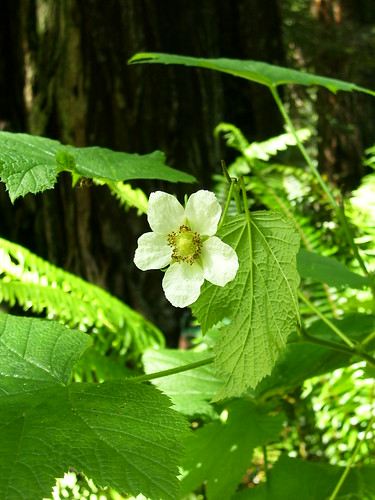
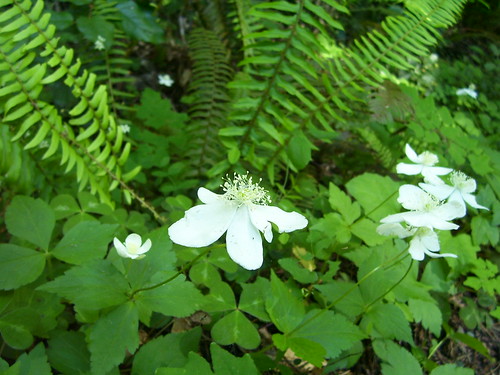
Comparison of redwoods and sequoias, from the Redwood National and State Parks (National Park Service) and Visit Sequoia / Sequoia National Park websites:
Giant redwood trees grow naturally only along a narrow belt (a few hundred miles) on the Northern California coastline. They thrive in a moist, humid climate, and the near-daily coastal fog provides them with exactly the kind of conditions they need to grow. The fog adds moisture to the soil and lowers their rate of evaporation as well.
Giant sequoias live at a much higher altitude. They grow naturally only along the western slope of California's Sierra Nevada mountain range, mostly between a 5,000 and 7,000 foot elevation level. While the temperatures in Sequoia National Park are fairly mild year-round, sequoias need a period of dry heat for their cones to open and release their seeds.
Giant redwood trees are the tallest trees in the world, reaching heights of up to 378 feet tall. Their base can be up to 22 feet in diameter and they can weigh up to 1.6 million pounds. The trees can reach ages of 2,000 years and regularly reach 600 years.
Resistance to natural enemies such as insects and fire are built-in features of a coast redwood. Diseases are virtually unknown and insect damage insignificant thanks to the high tannin content of the wood. Thick bark and foliage that rests high above the ground provides protection from all but the hottest fires.
Giant sequoias, on the other hand, don't grow quite as tall but can still reach a very impressive height of up to 311 feet (that's still the size of a 31 story building!). While not the tallest, giant sequoias are the largest trees in the world (ie – in volume). Their base can be up to 40 feet in diameter and a mature tree can weigh as much as 2.7 million pounds.

Finally, finally, we were able to bask in the dappled sunlight under the redwoods, the other bookend to our summer of the BIG trees.
Posted by
Wendee
at
4:36:00 PM
2
comments
![]()
Saturday, September 17, 2011
Running update
 |
| On my way to the gym for that 400th mile |
Finally got past 400 miles for the year! Woot!
I'm on a good pace to get to 500 miles for the year. If I knew my foot could take it, I'd increase my weekly miles so I could get in 600 miles, which is what I'd really like to accomplish... but I don't think my foot is quite there yet. Ergh.
Follow the details of my running here. I post my mileage and worry incessantly about recurring/lingering aches and pains.
This week's miles fueled by lots of birthday cake:
Posted by
Wendee
at
11:07:00 PM
0
comments
![]()
Labels: running
Friday, September 09, 2011
In the garden
Posted by
Wendee
at
8:00:00 AM
0
comments
![]()
Wednesday, September 07, 2011
Drive up the Coast, part 3: North to the Redwoods!
As much as we wanted to stay in lovely Carmel Valley, we needed to time our travel so that we'd be able to secure a campsite over the Fourth of July weekend. We pulled up out stakes, had one last breakfast of chocolate and almond pastries, and headed North.
Somewhere along Coastal Highway 1, I wrote: 'Miles and miles of crops', and I know I sighed, “I just love California”.
No, in all that dreamy sighing, I didn't think to stop to take photos of all that farmland.
[sigh]
We stopped to take photos of Pigeon Point Lighthouse, just south of Pescadero, California, then drove up to the lighthouse and stopped to walk around and take more photos.
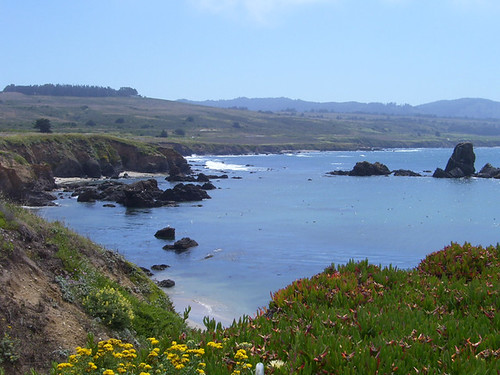

From the California State Parks website:
Perched on a cliff on the central California coast, 50 miles south of San Francisco, the 115-foot Pigeon Point Lighthouse, one of the tallest lighthouses in America, has been guiding mariners since 1872. Its five-wick lard oil lamp, and first-order Fresnel lens, comprised of 1,008 prisms, was first lit at sunset, November 15, 1872. The lens stands 16 feet tall, 6 feet in diameter, and weighs 8,000 pounds. It sits in a lantern room that had been constructed at the Lighthouse Service's general depot in New York before being shipped around the Horn. Although the original Fresnel lens is no longer in use, the lighthouse is still an active U.S. Coast Guard aid to navigation using a 24 inch Aero Beacon.

The lighthouse is currently closed to the public, but the grounds remain open.
The lighthouse keeper's housing is restored and operated as a Hostel.
We meandered along the boardwalk and breathed in deeply of the ocean air and peace.
Back on the road, our goal was to get past San Francisco and into redwood country.
We stopped at the Golden Gate Bridge and exclaimed, “Fog! Ha! What are the chances?!?!”

We drove and drove and drove, and finally stopped at Standish-Hickey State Recreation Area in Leggett, CA and secured a campsite. Sure enough, the park brochure proclaimed this as “the Gateway to California's Redwood Country”...
Posted by
Wendee
at
2:36:00 PM
0
comments
![]()
Thursday, September 01, 2011
Drive up the Coast, part 2
We stayed at the campground at Carmel Valley for two nights and enjoyed having a home base from which to explore Carmel and Monterey. We also enjoyed having showers that didn't require tokens or quarters, or were on a timer, as well. You can imagine. Timed/token showers loomed ahead...
We drove into Monterey, found a wonderful bakery and fueled up with more coffee and chocolate-y almond-y pastries. Heaven! We meandered along the coast, basking in the sun after the fog lifted. So many miles of beach and ocean… We were tempted to go ahead and commit to another night at the site or maybe stay even longer. The original plan was to see the Redwoods, then make it up to Olympic Peninsula, to see Mt Rainier and the fields wildflowers. Or maybe even get to Vancouver, to see the Olympic venues. Getting that far north would mean we couldn't linger for too long in any one place, though. And, however far north we reached, we needed to be able to head back home in time for me to teach on Monday, July 11th. We could make it to Seattle, but would need to pace our way up along the coast, that's for sure. But there in Monterey, we thought, just maybe, we could stay put right there and plan on a long, deep dive into the area … very much tempted by the thought of return visits to Paris Bakery.
We drove along from Monterey then decided to do 17–Mile drive, stopping at all the marked stops: Pebble Beach, Spyglass Hill, Bird Rock, the Lone Cypress, Pescadero Point.
From the Pebble Beach Resorts brochure:
“Before the automobile had become a way of life, 17–Mile Drive was navigated by horse-drawn carriages from the famous Hotel Del Monte, now the site of the Naval Postgraduate School in Monterey. It was 1881 and excursions through Del Monte Forest and along its spectacular coastline often ended up at a picnic spot at Pebble Beach…”
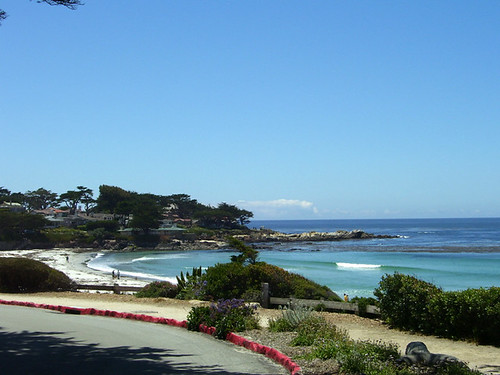
We ogled the views, the big homes with ogle-able private views, paused to whip up lunch (PB&J, fresh fruit and granola bars). We stopped and watched the otters and seals. We made a pit stop at the Lodge at Pebble Beach. In the lobby, there were the most beautiful, huge, paintings that captured the bright sunlight and deep, leggy shadows on pristine white sand beaches. Or, at least that's how I remember them.
Dumbfounded, I ogled those for a while.
But did I get pictures? I was far too spellbound. Alas!
We (I) quickly found that it was hard to choose between being spellbound with enchantment for the beauty of it all and thinking to slip behind the lens of a camera to actually capture it. Sigh.
We came upon Point Pinos Light House and discovered that the park was closed that day! Oh no! We could always come back; or would we? We could certainly improvise and make the best of it. It turned out that we happened upon several other landmarks that we'd normally spend much more time at, only to arrive to closed gates. We are not so easily deterred, as you can see:

Pt Pinos, navigating the closed gate and fence.
The oldest, continuously-operating lighthouse on the West Coast. Lit February 1, 1855.

The Carmel Mission, built in 1771 by Father Junipero Serra. Peering wistfully over the stone wall, after closing.
It was about at this point that it occurred to me that one of us was intent on photographing lighthouses and
bridges and the other of us wanted to paint within the garden walls of all the missions along the way. The lighthouses won; the comprehensive tour of California missions will have to wait for another trip. There were plenty of lighthouses and even more bridges, and plenty of mighty fine places to paint along the way, of course.

Carmel River Lagoon and Wetlands Natural Preserve

We stopped at Julie Pfeiffer State Park and hiked to the falls. We were really struck by all the clover (Redwood sorrel?) all around us. We plucked one and managed to carefully stash it away so that it survived the rest of trip.
At about this point, I realized there was no way I was jotting down the spots we'd stopped at quickly or accurately enough. No way that the Campsites of Southern/Central and Northern California maps that we'd brought along showed enough detail to help me recall our path for each day. I would need much more detailed maps to refer to. I tried to take photos of signs at each spot, but even just two days into our trip, and not even out of 'Central' California, oh my, we had so many pictures and so many more wishes to return to take pictures, but not enough of a photographic memory to remember where to return to.

Note to self: Take the time to take better notes.
All the photos from the trip are here.
Posted by
Wendee
at
10:00:00 PM
0
comments
![]()
Tablerunner: Finished!
This post is especially for my quilty/sew-y compadres. You know who you are (but I'll post links to your blogs all the same so everyone else will know. Bwa-ha-ha!).
I've finished the tablerunner for our coffeetable! Yay! Wow, did I really not post photos of this in-progress, here on the blog? You might have seen them in my Flickr stream. See the old quilt for comparison, here.

All done. Quilted (see, Donna? Straight grid) and bound, with mostly neat mitered binding. There may or may not have been cussing involved with the mitering, I won't say.

I managed to find matches for the colors in the fabric in our sofa, which certainly says something about either my eye for colors or how much I have in my stash to choose from (again, I won't say). I managed to not buy any additional fabric (or batting) for this project, except for the binding material. Because I'm just very particular about things like that.
Okay! Done!
The BigBear goes, "Oh, man. I'm going to have to be neater about eating...", and I'm thinking, "You 'n me both". Yes, we're slobs enthusiastic eaters. Never mind that he just made a bowl of buttered popcorn. Chances of getting a buttery splotch on the new tablerunner on Day 1? That's what it's there for, right? To be well-used?
I'm in quite the quilting frame of mind, so am putting together tops from pieced blocks that I already have (plenty to choose from there as well) and am hoping to get back into some freemotion quilting.
Stay tuned.
Posted by
Wendee
at
8:18:00 PM
3
comments
![]()
Labels: sewing
Monday, August 29, 2011
Drive up the Coast, Part 1: Having faith
So there we were, driving up the coast.
We'd stayed overnight in Santa Barbara, which is barely like Southern California, and also just barely not. We were somewhere in between … After breakfast at Tupelo Junction, we headed North, determined to get to Carmel / Monterey. We weren't sure where we'd stay, but knew that we wanted to get at least that far on our first official day of driving...
 |
| Driving up the coast with Pooh Bear (circa 1988) |
Not having a plan seemed a looming challenge for me. I'd driven up the coast in about 1988 and the challenges that I encountered then seem so far away: not having cel phones (ie, they didn't exist) and losing FM radio signal as I meandered along. I had a plan, a destination, and more importantly, a reservation. If I didn't show up, someone would take notice. And I had plenty of quarters - - there had to be plenty of pay phones along the way. I have memories of curvy roads along the coast and small towns that I stopped to say hello to.
 |
| In Harmony, CA (circa 1988. Note the perm and fanny pack!) |
During that trip, not only was I often outside of FM signal range, I remember very distinctly that my tape deck stopped working as well. It was unnerving, driving alone, without music, curving up a particularly steep hill. At that point, leaving Morro Bay, I was impatient to get closer to my destination already. Having the ocean off my left shoulder, down steep cliffs, was immediately less romantic.
So this time (2011), we drove through Pismo and Shell beaches, as perhaps everyone does when one drives up the coast. We stopped at Morro Bay and spotted otters, a sure sign that we were indeed well outside of Southern California. Although we'd both made the drive before, separately, neither of us realized that you could drive up to Morro Rock, so this time, together, we did. We took another look at the otters, wished there was less fog, then headed on.
Further up the coast, my notes say we stopped at San Simeon, surrounded by bright mustard blooms. J took photos as the fog cleared.



We'd tried to work through some of the small challenges that we could imagine during the trip to Kings Canyon – got new camp beds, figured out a better way of making two cups of robust morning coffee, expanded beyond our very basic camping cooking repertoire. Slightly bigger challenges during that trip - - keeping our site bear-safe and outsmarting mosquitos - - those will always remain challenges.
The challenges in 2011 seemed to revolve around having faith. What do we depend on: our intuition or the safety blanket of technology? I'd just gotten a smartphone. I wanted to be able to stay in touch without lugging around a laptop. I didn't expect this battle of wits – J wanted to find his own way and I needed the security of knowing where I was, what direction I was going. The information was there and I wanted to be able to use it. Ultimately we found compromise: We found that using my smartphone we could check traffic, navigate us through the traffic jams in small and big towns, properly identify upcoming landmarks and geography without having to unfurl paper maps, and could find the nearest gas station as our tank ran precariously low.
But as the daylight grew more and more dim, no amount of descriptions and reviews could help us as we read signs that read “Campsite Full” as we passed by them, closer and closer to Carmel. It was the exceedingly low-tech guide, though, of alternate campsites printed on a handout that a ranger at a (full) campground gave us that steered us into Carmel Valley, where we found a campground with plenty of room. We were the only tent campers that night (lots of RVs though) and the host looked at us sympathetically as it started to rain as she took our information.
Night #1 helped us know that we could find our way and have faith that we could find our way home and be able to keep in touch both ways. And not strangle each other in the process.
In Carmel Valley, we also knew this: We had made our way, with a little bit of low-tech help and had a place to rest. We could set up camp in the rain and the tent stayed water-tight.
We slept deeply through passing showers.
Posted by
Wendee
at
12:03:00 PM
0
comments
![]()
Tuesday, August 23, 2011
Magenta ribbons
 |
| See the reflection? Ooooh.... nice ... |
I did run across a great blog post that I wanted to pass along, though. I wish I had written it and taken those photos; do you ever run across writing like that? You wish you'd written it? Couldn't I have given up going on and on about our new camp beds and written something more thoughtful about the Sequoias, like this? I read this and went, "Doh!". Thankfully, that quickly gave way to, "Ooooo, look at those photos...". We were in the same place, having the same thoughts about these lovely, majestic giant trees. I'm grateful that one of us got out the words that really need to be said. Go and click on over, and enjoy a visit with the giant Sequoias.
You'll thank me. And you'll thank Alissa (thanks, Alissa!).
Posted by
Wendee
at
11:57:00 AM
0
comments
![]()
Labels: ArtCenter, celebrations, SOBT
Wednesday, August 10, 2011
Summer of the Big Trees: Kings Canyon and Sequoia National Parks
Our first trip of the summer was to Kings Canyon / Sequoia National Park. We'd wanted to go to Cedar Grove, but the Kings river was running too high. With the record snow levels during the winter and the warm temps in mid-June, we could only imagine the river running higher during the days. Getting stranded on the other side of the bridge would be an adventure (!), to be sure, but not one that we were real keen on. So we turned back and camped at Grant Grove (flush toilets, running water, but no showers).
We did two hikes during our stay and saw a bunch of bears. Unlike the Yosemite bears, they weren't scrounging around for people food (we've had to scare them away from stealing our breakfast at Yosemite), and seemed pretty content to munch down on bear food in the meadows. All the same, I didn't feel like stopping longer to gawk and take photos of them. They were plenty close enough.
After our dinners, we'd head over the Grants Grove at sunset, to finish off our Heinekens or ice cream and photograph the big, big trees, the giant sequoias. It's hard to imagine how big the trees are, and just as tough to capture their size of the trees in photographs – – J and I took quite a few photos, trying to capture the golden rays of sunset bathing these majestic trees. None of mine do them justice. I suggest you go to see them in person!
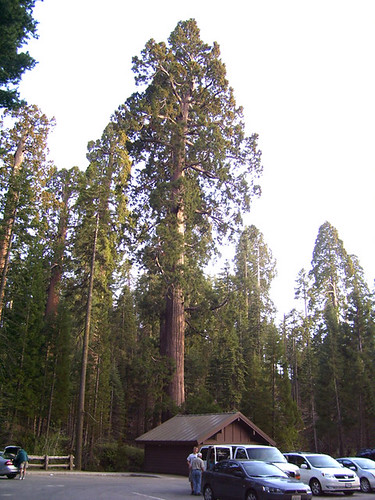

Knowing we'd be visiting the redwoods in a week afterwards, we decided then and there to dub this our Summer of the Big Trees (SOBT).
The camping trip was a great chance to test out some of our gear for future trips. Right before we left, J splurged on REI 3.5 self-inflating camp beds (air mattresses). The REI product description says: “With an ultra-cushy 3.5-inch thickness and soft-touch stretch fabric upper surface, the REI Camp Bed 3.5 provides plush comfort for base camping.” So the '3.5' stands for thickness! Brilliant! We tested lying on them at the local REI, and yes, the 3.5's were way more comfy than the 2.5's. And, no, we weren't even going to worry about trying the 1.75's. During the trip, they were fantastic. Five stars and two thumbs up from both of us. I'd remark, every night: "Oooo, so comfy! So … zzzzz".
As an extra bonus, squeezing the air out of them when you roll them up gives you a chance to get in some weird yoga-like moves / stretches, if you were worried about not being able to keep up with your practice. Sorry, no pictures of that, either.
Here's TheBigBear, making up dinner:
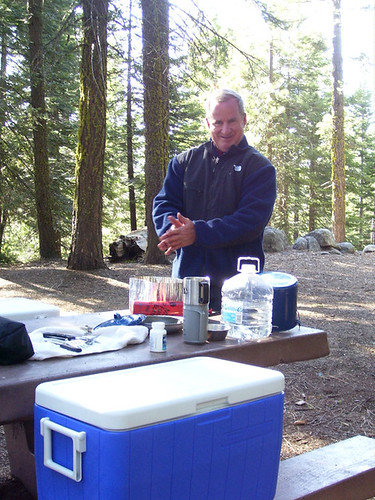
One of the Pudwill berries we brought along. Little comforts from home:

The view from our hike above Crescent Meadows (Sequoia National Park). Click on it to view it bigger at Flickr! :

A sketch of the meadow at Grant Village:

Posted by
Wendee
at
10:17:00 AM
2
comments
![]()










